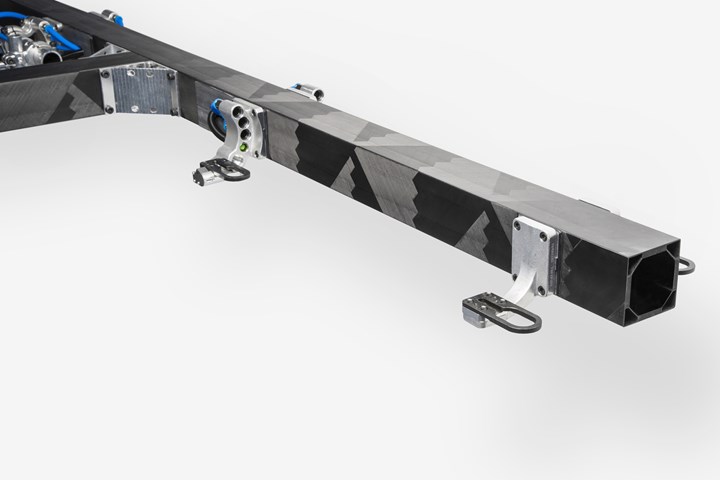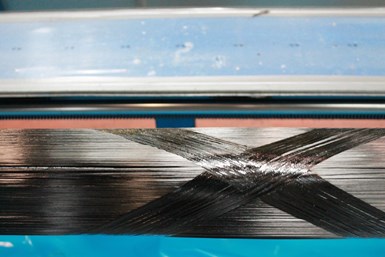CompoTech launches standard range for carbon finer epoxy beams
Produced via AFP and precision press molded results in a high-strength carbon epoxy composite beam with 10-15% higher stiffness in the axial direction.

Standard connected beam used for T-boom applications in press shop manipulation. T-joint and attachments are made by bolting to the inserts placed in the corners of the profile. Source | CompoTech
(Sušice, Czech Republic) has recently launched a new standard range of lightweight carbon finer (CF) epoxy composite beams in round tubes and square-shaped options and sizes, which can be specified instead of steel.
CompoTech says the standard square beams are produced from graphite and PAN carbon fibers using its automated robot-assisted filament placement technique, which places continuous fibers axially along the beam length. The result is a high-strength carbon epoxy composite beam with 10-15% higher stiffness in the axial direction and up to 50% greater bending strength compared to a conventional filament wound beam with the same dimensions.
All CompoTech beams are produced with automated filament placement (AFP) and precision press molded using a wet, two-part epoxy resin system. Curing is a two-stage process, first at room temperature to remove any residual stresses during molding that can cause deformation over time, then post mold curing in an oven. Compared with pultrusion, CompoTech says, its pressing technique provides a precision CF epoxy beam with very high dimensional accuracy and a close tolerance surface finish, which typically does not require costly CNC finish machining.
According to CompoTech, its carbon composite beams have enabled modular industrial tooling system producers, such as Bilsing Automation GmbH (Attendorn, Germany), to replace much heavier steel and aluminum beams, providing significant production benefits such as faster operating speeds and higher productivity; less vibration and more rapid damping; heavier load handling capabilities on the same line; lower energy consumption and lifetime operating costs; and easy assembly for structures needing bolted connections.

CompoTech winding of a graphite and PAN carbon fiber epoxy square beam. Source | CompTech
Successful applications in the aerospace, agricultural, automotive, metrology, marine and sports equipment market sectors for CompoTech products include industrial machine tool beams; drive shafts; automated automotive press line T-booms, structural frames and crossbars; crop sprayer booms; aerospace structures; yacht masts and spars; and composite bike frames.
The choice of standard square beam options includes hollow cornered ‘bolt together’ connector beams to extend length, and beams designed with reinforced corners for added stiffness, damping and load bearing performance.
Standard square beams are available in sizes from 60 x 60 x 5mm wall thickness, weighing 1.7 kg/m, with an E (elasticity) Modulus in the axial direction of 196 GPa, up to the largest beam 200 x 200 x 8mm, weighing 4.19kg/m, with E Modulus of 210 GPa, matching tool steel. The stiffest design achieves an E Modulus of 327 GPa, which is said to be 69% stiffer than stainless steel (193 GPa) and 56% stiffer than tool steel (210 GPa). Square beam lengths vary from between 2.3-5.0m depending on the size.
Standard CF epoxy round tubes, which have an E Modulus of 90 GPa, are manufactured using PAN carbon fibers. Tubes are available in sizes from a 428mm inside diameter x 4mm wall thickness, weighing 6.92 kg/m down to 10mm inside diameter x 2mm wall thickness, weighing only 0.11 kg/m. Standard tubes lengths are between 3.6-7.8m, depending on the diameter.
Both standard tubes and square beams are available in quantities from one-off to multiple batch orders. On request, CompoTech says it will look to add additional sizes to the standard round and square beam ranges, as well as continuing to offer its bespoke design and manufacturing service for industrial beams and other CF composite components to meet specific customer requirements.
Related Content
Design for manufacturing, assembly and automation enables complex CFRP telescope supports
Airborne delivered two mirror support structures for the FYST and SOLAT telescopes, assembling 26,300 components while maintaining near-zero CTE, strict tolerances on 6.5 × 6.5 × 1.8-meter assemblies.
Read MoreThe potential for thermoplastic composite nacelles
Collins Aerospace draws on global team, decades of experience to demonstrate large, curved AFP and welded structures for the next generation of aircraft.
Read MoreCombining multifunctional thermoplastic composites, additive manufacturing for next-gen airframe structures
The DOMMINIO project combines AFP with 3D printed gyroid cores, embedded SHM sensors and smart materials for induction-driven disassembly of parts at end of life.
Read MorePlant tour: Airbus, Illescas, Spain
Airbus’ Illescas facility, featuring highly automated composites processes for the A350 lower wing cover and one-piece Section 19 fuselage barrels, works toward production ramp-ups and next-generation aircraft.
Read MoreRead Next
Ultrasonic welding for in-space manufacturing of CFRTP
Agile Ultrasonics and NASA trial robotic-compatible carbon fiber-reinforced thermoplastic ultrasonic welding technology for space structures.
Read MoreNext-gen fan blades: Hybrid twin RTM, printed sensors, laser shock disassembly
MORPHO project demonstrates blade with 20% faster RTM cure cycle, uses AI-based monitoring for improved maintenance/life cycle management and proves laser shock disassembly for recycling.
Read MoreScaling up, optimizing the flax fiber composite camper
Greenlander’s Sherpa RV cab, which is largely constructed from flax fiber/bio-epoxy sandwich panels, nears commercial production readiness and next-generation scale-up.
Read More












